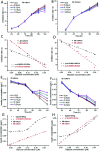High-glucose 3D INS-1 cell model combined with a microfluidic circular concentration gradient generator for high throughput screening of drugs against type 2 diabetes
- PMID: 35539797
- PMCID: PMC9082620
- DOI: 10.1039/c8ra04040k
High-glucose 3D INS-1 cell model combined with a microfluidic circular concentration gradient generator for high throughput screening of drugs against type 2 diabetes
Abstract
In vitro models for screening of drugs against type 2 diabetes are crucial for the pharmaceutical industry. This paper presents a new approach for integration of a three-dimensionally-cultured insulinoma cell line (INS-1 cell) incubated in a high concentration of glucose as a new model. In this model, INS-1 cells tended to aggregate in the 3D gel (basement membrane extractant, BME), in a similar way to 3D in vivo cell culture models. The proliferation of INS-1 cells in BME was initially promoted and then suppressed by the high concentration of glucose, and the function of insulin secretion also was initially enhanced and then inhibited by the high concentration of glucose. These phenomena were similar to hyperglycemia symptoms, proving the validity of the proposed model. This model can help find the drugs that stimulate insulin secretion. Then, we identified the difference between the new model and the traditional two-dimensional model in terms of cell morphology, inhibition rate of cell proliferation, and insulin secretion. Simultaneously, we developed a circular drug concentration gradient generator based on microfluidic technology. We integrated the high-glucose 3D INS-1 cell model and the circular concentration gradient generator in the same microdevice, tested the utility of this microdevice in the field of drug screening with glipizide as a model drug, and found that the microdevice was more sensitive than the traditional device to screen the anti-diabetic drugs.
This journal is © The Royal Society of Chemistry.
Conflict of interest statement
The authors declare neither conflict of interest nor competing financial interest.
Figures





Similar articles
-
High-Throughput Screening of Anti-cancer Drugs Using a Microfluidic Spheroid Culture Device with a Concentration Gradient Generator.Curr Protoc. 2022 Sep;2(9):e529. doi: 10.1002/cpz1.529. Curr Protoc. 2022. PMID: 36066205
-
Long-term exposure of INS-1 rat insulinoma cells to linoleic acid and glucose in vitro affects cell viability and function through mitochondrial-mediated pathways.Endocrine. 2011 Apr;39(2):128-38. doi: 10.1007/s12020-010-9432-3. Epub 2010 Dec 15. Endocrine. 2011. PMID: 21161439
-
A simple, reliable method for high-throughput screening for diabetes drugs using 3D β-cell spheroids.J Pharmacol Toxicol Methods. 2016 Nov-Dec;82:83-89. doi: 10.1016/j.vascn.2016.08.005. Epub 2016 Aug 20. J Pharmacol Toxicol Methods. 2016. PMID: 27554916
-
Extracts from Leonurus sibiricus L. increase insulin secretion and proliferation of rat INS-1E insulinoma cells.J Ethnopharmacol. 2013 Oct 28;150(1):85-94. doi: 10.1016/j.jep.2013.08.013. Epub 2013 Aug 24. J Ethnopharmacol. 2013. PMID: 23978659
-
Miniaturized microfluidic formats for cell-based high-throughput screening.Crit Rev Biomed Eng. 2009;37(3):193-257. doi: 10.1615/critrevbiomedeng.v37.i3.10. Crit Rev Biomed Eng. 2009. PMID: 20402621 Review.
Cited by
-
Microfluidic High-Migratory Cell Collector Suppressing Artifacts Caused by Microstructures.Micromachines (Basel). 2019 Feb 11;10(2):116. doi: 10.3390/mi10020116. Micromachines (Basel). 2019. PMID: 30754704 Free PMC article.
-
Machine-Learning-Enabled Design and Manipulation of a Microfluidic Concentration Gradient Generator.Micromachines (Basel). 2022 Oct 24;13(11):1810. doi: 10.3390/mi13111810. Micromachines (Basel). 2022. PMID: 36363832 Free PMC article.
-
Nanoscale dynamic chemical, biological sensor material designs for control monitoring and early detection of advanced diseases.Mater Today Bio. 2020 Feb 14;5:100044. doi: 10.1016/j.mtbio.2020.100044. eCollection 2020 Jan. Mater Today Bio. 2020. PMID: 32181446 Free PMC article. Review.
-
A Tumor-on-a-Chip System with Bioprinted Blood and Lymphatic Vessel Pair.Adv Funct Mater. 2019 Aug 1;29(31):1807173. doi: 10.1002/adfm.201807173. Epub 2019 May 1. Adv Funct Mater. 2019. PMID: 33041741 Free PMC article.
-
New Frontiers in Three-Dimensional Culture Platforms to Improve Diabetes Research.Pharmaceutics. 2023 Feb 22;15(3):725. doi: 10.3390/pharmaceutics15030725. Pharmaceutics. 2023. PMID: 36986591 Free PMC article. Review.
References
LinkOut - more resources
Full Text Sources

